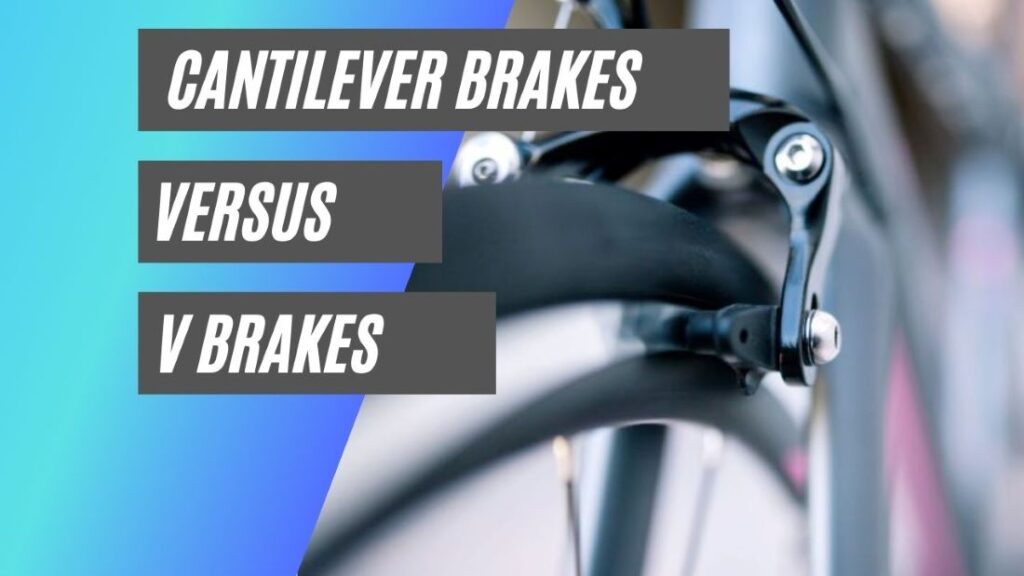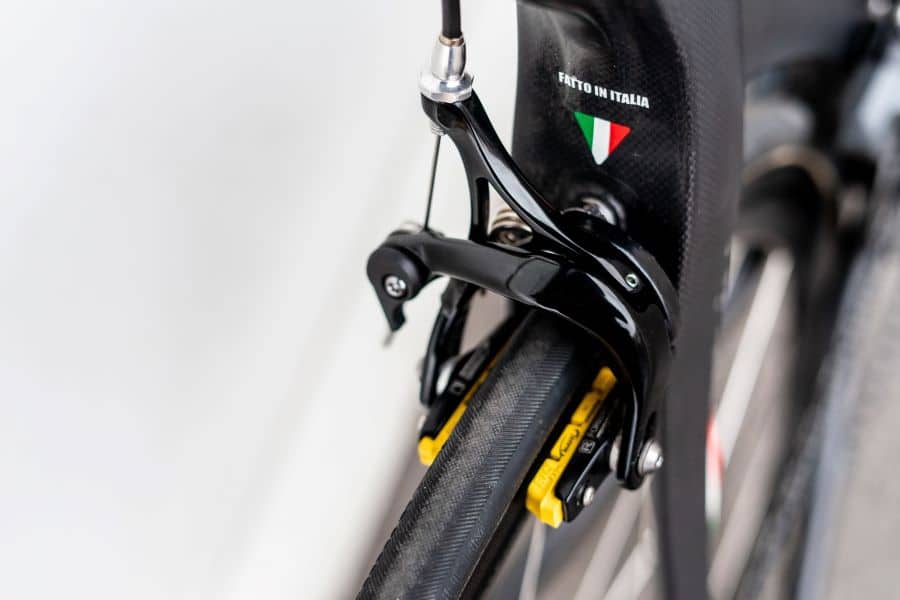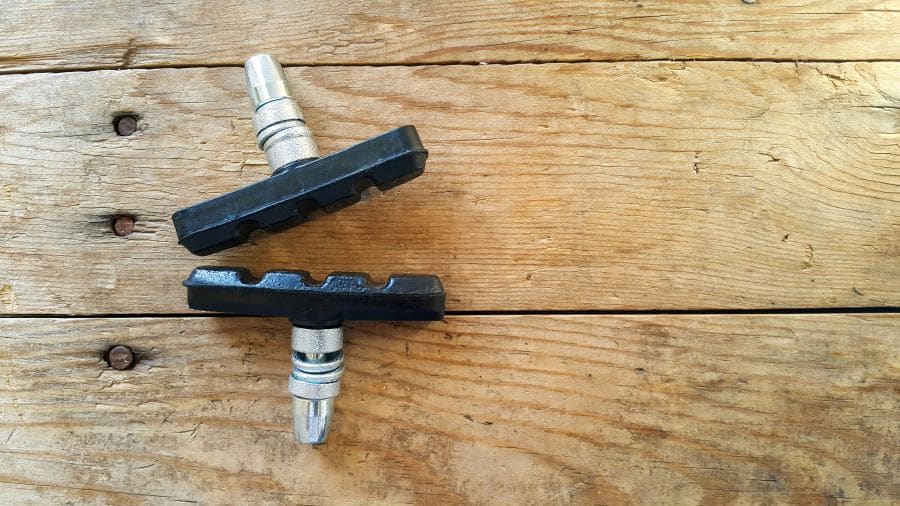This post may contain affiliate links. If you click an affiliate link and make a purchase, I may earn a commission. Also, as an Amazon Associate, I earn from qualifying purchases.--
There are many different kinds of brakes, but the most commonly used are cantilever brakes, V brakes, and disc brakes. Cantilever and V brakes are both types of caliper brakes. As a cyclist or someone who’s looking to get into cycling, it can be confusing which ones are better and why, so today I will explain the pros and cons of cantilever brakes vs V brakes.
Cantilever brakes are much harder to adjust than V brakes. However, V brakes have less clearance, and for this reason, cantilevers are better for muddy conditions. V brakes are also stronger and when braking they’re easier on your hands.
Each of these factors needs a bit more explaining to see exactly which type of brakes will be best for you.
So, below I will explain each of these pros and cons. I’ll also explain how V brakes and cantilever brakes compare to the other kinds of bicycle brakes there are.

The Advantages of Cantilever Brakes Over V Brakes
Cantilever brakes are an older style of bicycle brake but are still quite common. Cantilever brakes overall are certainly no better than V brakes, but here’s the advantage of cantilever brakes over V brakes.
There is one advantage cantilever brakes have over V brakes: they have more clearance between the brakes and the rim of the tire. This is good for muddy conditions. With V brakes mud can catch on the brakes and make it more difficult to pedal.
Also, on cantilever breaks the mud can pass underneath the brake pads and fling off.
Other than that, V brakes are superior. This is why:
- V brakes are much easier to adjust
- V brakes are easier to squeeze and use
With that said cantilever brakes perform really well, and are good brakes to have.
Below, is a detailed explanation of the reasons why V brakes are superior to cantilever brakes. After you have the gist of why V brakes are superior, I’ll explain if cantilever brakes can be replaced with V brakes and if it’s difficult to do.
The Advantages Of V Brakes Over Cantilever Brakes
1. V brakes are easier to adjust than cantilever brakes
Caliper brakes have two wires that connect from the brake pads to a central point. If one of the wires is too loose, it’s more of a pain to adjust than V brakes. With V brakes each of the wires can be tightened separately with a screw on the brake mechanism.
Caliper brakes also have multiple directions that can be adjusted for the brakes pads themselves. This can be quite frustrating to get it at the right height and the right angle. With V brakes the pads are held fixed and aren’t nearly as fiddly and require multiple tweaks to get them where they need to be.
All brake pads need to be adjusted fairly regularly to keep them working well. You can go a long time without adjusting them and it can be fine. But, it’s generally best to aim to adjust them every two weeks to a month depending on if you use them every day or only every few days or less.
For competitive riding where the best time wins, you need to adjust them before any big race, and it gives you a competitive advantage. For that reason having V brakes saves a lot of time.

2. V brakes are easier to squeeze and use
Most people report that V brakes require less strength to squeeze. This is due to the design of V brakes. Both types of brakes are capable of locking out the wheels. This is where you squeeze hard enough that the tire stops completely.
This is a big advantage if you ride fast, or if you ride downhill a lot. As you may know, if you bike uphill at some point you’re going to go downhill again. So, if where you ride it is relatively flat this is less of an issue. But, still significant if you ride fast and brake hard.
Also, if you’re a heavier individual, V brakes are much better because you will need to use more force to slow down and stop.
If you ride predominantly in city-type settings, such as every day to work to commute, then the extra stopping power is much safer.
The reason is unpredictable things happen more in the city. Cars can pull out suddenly, you can not see a pedestrian or an obstacle, and needing to brake suddenly happens more.
For that reason, being able to stop quicker with V brakes is more necessary. And one could argue disk brakes are a better option for this kind of riding.
Replacing cantilever brakes with V brakes [possible on the same bike?]
It’s possible to replace cantilever brakes with V brakes. Here’s a video that shows the process which isn’t too difficult:
V brakes cost around $15 to $25 each, so about $30 to $50 for a pair. These are some of the highest quality ones from brands like Shimano. There can be some additional tools you may not yet have, shown in the video.
Cantilever Brakes vs V brakes vs Disk Brakes
The three types of brakes that are most common on bikes are cantilever, V brakes, and disk brakes.
Since I’ve covered the pros and cons of cantilever brakes over V brakes and that V brakes are generally the best option, here are the reasons why disk brakes are better or worse than V brakes:
- Easier to stop and have more stopping power than V brakes
- If tires aren’t true you can continue to ride with disk brakes
- Hydraulic disk brakes auto-adjust as the brakes wear
- The rims don’t wear when braking
- Work well in all conditions including rain
Easier to stop and have more stopping power than V brakes
It’s a well-known fact that disk brakes have more stopping power, and they’re much easier to squeeze than V brakes and cantilever brakes (source). I’ve noticed that many top cycle stores online don’t list this as a factor for whether disc brakes or V brakes are better. But, this is indeed the cast as reported by many people online in forums.
For heavy riders, this is also a huge advantage. The power of the brakes to slow and stop the bike is a lot more for a heavier person.
If tires aren’t true you can continue to ride with disk brakes
With cantilever and V brakes the design of the brakes is such that if the wheel it’s true the brakes don’t perform nearly as well. By true is meant perfectly flat. The brakes sit perfectly flat against the tire with cantilever and V brakes.
It’s common for tires to go out of shape particularly if you hop curbs when using your bike for commuting. Or you miss something on the road or footpath that causes the bike to bump hard into it.
Generally, with strong braking, the brakes can come out of position when the tire isn’t true. Or, it wears the brakes unevenly and you need to replace them a lot sooner.
Hydraulic disk brakes auto-adjust as the brakes wear
There is a special type of disk brake called a hydraulic disk brake. These kinds of brakes automatically adjust as the brakes wear down. The other 2 types of brakes – rim brakes and regular disk brakes need to be manually adjusted.
This isn’t so much of a chore with V brakes and is generally quite easy. But, with cantilever brakes, this can be very frustrating. As previously mentioned, cantilever brakes can be a real pain to adjust.
Work well in all conditions including rain
This is the main draw of getting disk brakes. In wet weather, snow, wet conditions, and hail cantilever and V brakes don’t brake as fast. And are prone to slipping which can be very dangerous. You need to apply much more force.
You also need to remember to do so, and often the habit a rider acquires of braking at certain times can cause you to have a bit of a panic.

Are V Brakes the Same As Cantilever Brakes
There are a few different types of rim brakes. Two common types of rim brakes are V brakes and cantilever brakes.
All of the terminology used for brakes can be a bit confusing, so here’s whether V brakes and cantilever brakes are the same thing.
V brakes are not the same as cantilever brakes. Both are a type of caliper brakes so they share similarities. The difference is the 2 wires on cantilever brakes connect in an upside-down V at the top of the brakes. Whereas, V brakes have a horizontal connection above the tire.
Another common name for V brakes is linear brakes. This is because the part of the brake that squeezes together is flat and straight. V brakes and cantilever brakes are very easy to tell apart.
Simply inspecting the brakes on the front tire you can see how the wires connect. If the wires form an upside-down V and connect at a single point about 3 inches (7.5 cm) above the tire, then they are cantilever brakes.
It can be a bit tricky to remember because brakes with a V-shaped connection at the top are cantilever brakes.
V brakes only form a V when the brakes are squeezed
The way they move is a bit counter-intuitive. When they’re squeezed the brake at the top gets drawn together. This pushes the part below outwards, which would cause the brakes to get further away from the tire rim.
But, because the brake pads are positioned in the middle of the arms. When the arms of the brake form a V, it pushes the brake pads into the rim of the tire.
Another type of bicycle brake that have a letter in the name is U-brakes. These are a bit different from V brakes but like cantilever brakes, they are a type of rim brake, and also a type of caliper brake.
In another article I explained the differences between V brakes and U brakes, and what kind of bikes U brakes are commonly used on.
Are V Brakes Good?
Without trying each and every type of brake out there, you can’t know how good one type of brake is over another. V brakes are very popular and are very common on many of the different types of bikes.
So, I thought I’d explain how they compare to other brakes and if they’re good.
Overall, V brakes are good. They are the best type of rim brakes. The reasons are because they are the easiest to squeeze, and they’re the easiest to adjust. The only brakes that offer superior performance are disk brakes. But, V brakes still perform well enough that disk brakes aren’t always necessary.
Disk brakes are more expensive than V brakes. But, all things considered, they are still relatively cheap compared to the cost of the frame, and other components.
For example, a set of V brakes from the top brands can set you back about $30, whereas, a set of disk brakes costs around $100, and sometimes much less.
Considering that a midrange bike costs around $500. Disk brakes do cost a significant amount of the total cost of a bike.
However, if you have a high-end bike that costs in the range of $1000 or more, it’s not much of a difference to get disk brakes instead of V brakes.
Why Are They Called V Brakes?
Cantilever brakes have a V shape at the top where the wires meet. But, if you take a look at V brakes, it’s hard to see how they get their name because they don’t have a V shape to them at all. Here’s the reason why V brakes are called V brakes.
V brakes form an upside-down V when they’re engaged. When V brakes aren’t being used they have an upside-down ‘U’ shape. While the brakes are being used the top part is drawn together. This causes the top part of the upside-down ‘U’ to shorten creating a ‘V’ shape.
The tightening of the wire occurs when the lever is squeezed. As you may know one lever on the handlebars controls the front brake, and the lever on the other handlebar controls the back brake. When the lever is squeezed it pulls the wire and shortens the part of the brake above the tire.
